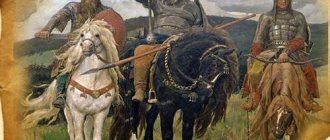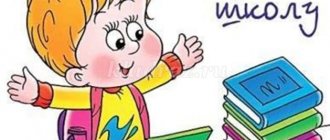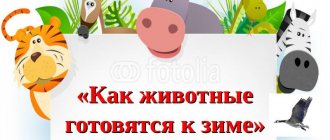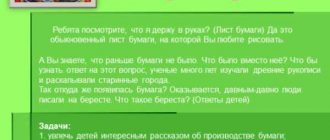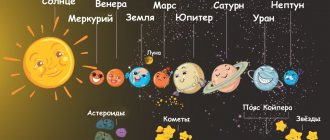Presentation “Russian heroes - epic heroes”
#Teaching and methodological materials #Presentation #All teachers #Educator #Intern student #Preschool education
“Russian heroes - epic writers” Educator: Shirkina V.L.
I’ll tell you about old deeds, Yes, about old things, about experienced ones, Yes, about battles, and about battles, Yes, about heroic deeds!
Bogatyrs Bogatyrs are epic images of heroes of ancient Slavic tribes. The heroes stood guard over Rus', at the outpost. Images of Russian heroes are widely reflected in the works of famous artists, for example, Mikhail Aleksandrovich Vrubel - the decorative panel “Bogatyr”, or Viktor Mikhailovich Vasnetsov - “Bogatyrs” (a painting that he painted for almost twenty years).
The meaning and origin of the word “hero” This word has several meanings: Hero of Russian epics and fairy tales. Defender of the homeland, a warrior distinguished by extraordinary strength, courage, and daring. Tall, well built, strong man. An extraordinary, outstanding person.
In ancient times, back in ancient Rus', very strong people - heroes - stood guard over the borders of our Motherland at the outpost. People composed songs and tales about them, which were called epics. These are the heroes depicted by the artist Vasnetsov in this painting (Vasnetsov’s painting “Bogatyrs” is included). Hero-heroes made the purpose of their lives to serve their Motherland - Rus'. When the heroes gathered together, as we see in Vasnetsov’s painting, they became so strong that it was impossible to defeat them. Bogatyrs have more or less common properties: strength and youth. Although epics often speak of the “old Cossack” Ilya Muromets, here the word old does not mean “burdened with years,” but only mature, experienced in military affairs. In ancient times, back in ancient Rus', very strong people - heroes - stood guard over the borders of our Motherland at the outpost. People composed songs and tales about them, which were called epics. These are the heroes depicted by the artist Vasnetsov in this painting (Vasnetsov’s painting “Bogatyrs” is included). Hero-heroes made the purpose of their lives to serve their Motherland - Rus'. When the heroes gathered together, as we see in Vasnetsov’s painting, they became so strong that it was impossible to defeat them. Bogatyrs have more or less common properties: strength and youth. Although epics often speak of the “old Cossack” Ilya Muromets, here the word old does not mean “burdened with years,” but only mature, experienced in military affairs.
Victor Vasnetsov “Bogatyrs on Horses.” 1896.
Behind the name of each of the epic heroes there is a specific person who lived once upon a time in Rus', and who accomplished his feats only in the epics their characters are embellished by the people. Behind the name of each of the epic heroes there is a specific person who lived once upon a time in Rus', and who accomplished his feats only in the epics their characters are embellished by the people. A storyteller walked from village to village and spoke in a sing-song voice (like a song) about heroic heroes and their exploits. He talked about how it happened. About the deeds and victories of the heroes, about how they defeated evil enemies, defended their land, showed their bravery, courage, ingenuity, and kindness.
Ilya Muromets Ilya Muromets is the most popular hero of epics, a mighty hero. The epic does not know him as a young man, he is an old man with a gray beard. Oddly enough, Ilya Muromets appeared later than his epic younger comrades Dobrynya Nikitich and Alyosha Popovich. His homeland is the city of Murom, the village of Karacharovo. The peasant son, the sick Ilya, “sat sitting on the stove for 30 years and three years.” One day, wanderers came to the house, “walking kaliki.” They healed Ilya, giving him heroic strength. From now on, he is a hero who is destined to serve the city of Kyiv and Prince Vladimir. On the way to Kyiv, Ilya defeats the Nightingale the Robber, puts him in a Toroki and takes him to the princely court. Among other exploits of Ilya, it is worth mentioning his victory over the Idolishch, which besieged Kyiv.
MONUMENT TO ILYA MUROMETS IN THE CITY OF MUROM The image of the ancient Russian hero embodied folk concepts of the high moral qualities that a true hero should have. One of the most important qualities of Ilya Muromets is a sense of justice and awareness of his duty - to stand for the truth. He is ready to go into direct conflict with the prince, with the boyars, when he sees that they are not doing the truth. He is a hero of the whole people, all-Russian, not bound by any class ties. “I am going to serve for the Christian faith and for the Russian land, and for the capital city of Kyiv-grad, for widows, for orphans, for poor people.”
Dobrynya Nikitich The most popular hero of the Russian epic after Ilya Muromets. He embodies those qualities that the people collectively denoted by the word “knowledge”: education, excellent upbringing, knowledge of etiquette, the ability to play the harp, intelligence (Dobrynya plays chess superbly). In addition to the listed qualities, he, like all heroes, is brave and courageous. Since childhood (from the age of 12 or 15), Dobrynya has mastered weapons.
Alyosha Popovich Alyosha Popovich, as the youngest, is the third in importance in the heroic trinity, along with Ilya Muromets and Dobrynya Nikitich. Alyosha Popovich is distinguished not by strength (sometimes his weakness is even emphasized, his lameness is pointed out, etc.), but by courage, daring, onslaught, on the one hand, and resourcefulness, sharpness, cunning, on the other. The birth of Alyosha Popovich was miraculous, reminiscent of the birth of Volkh: it is accompanied by thunder; “Alyoshenka the Wonderful Young,” as soon as he was born, asks his mother for a blessing to walk around the world, not to swaddle him in swaddling clothes, but in chain mail; he can already sit on a horse and wield it, operate with a spear and saber.
Victor Vasnetsov “Bogatyr” 1878. – Defend your homeland, take care of it. - Protect the weak, the poor, the elderly and children. - Be strong, brave, courageous, courageous. - To love your native land, your people, your country and your Motherland. The covenant of the heroes to us, their descendants:
Russian epic heroes. - presentation
Russian epic heroes Literature lesson in 6th grade Tsapkina Berta Sergeevna Teacher of Russian language and literature MBOU "Secondary school 92 with in-depth study of individual subjects" Kemerovo
Russian epic heroes
Ancient Rus' is a historical period covering the period of time from the 9th to the 13th centuries. This period is called Kievan Rus because the main city at that time was Kyiv. Ancient Rus' occupied the territory of modern Ukraine, part of the Krasnodar region, part of the Volga region and part of the lands in the north between the Baltic Sea and two lakes - Ladoga and Onega. Physical map of Ancient Rus'...
Ancient Rus' Political map of Ancient Rus'
This was the capital of Ancient Rus'... Model of the central part of Kyiv
The whole world of ancient Russian life is revealed in epics. Their main character is a hero, a defender of the people. The heroes had enormous physical strength. So it was said about the beloved Russian hero Ilya Muromets: “Wherever he turns, there are streets, wherever he turns with alleys.” At the same time, he was a very peace-loving hero who took up arms only when absolutely necessary. As a rule, the bearer of such irrepressible power is a native of the people, a peasant son. The people's heroes also possessed enormous magical power, wisdom, and cunning. People's memory has preserved the image of heroes who came not only from the peasant environment, the boyar's son Dobrynya Nikitich, the cunning and resourceful representative of the clergy Alyosha Popovich. Each of them had its own character, its own characteristics, but they were all exponents of people's aspirations, thoughts, and hopes. And the main one was the defense of Rus' from fierce enemies.
In the epic images of enemies one can also discern the real foreign policy opponents of Rus', the fight against which has deeply entered the consciousness of the people. Under the name of Tugarin one can see a generalized image of the Polovtsians with their khan Tugorkan, the struggle with whom took an entire period in the history of Rus' in the last quarter of the 11th century. Under the name “Zhidovina” is Khazaria, whose state religion was Judaism. Russian epic heroes faithfully served the epic prince Vladimir. They fulfilled his requests for the defense of the Fatherland; he turned to them at crucial times. The relationship between the heroes and the prince was difficult. There were grievances and misunderstandings here. But all of them, the prince and the heroes, in the end decided on one common cause - the cause of the people. Scientists have proven that the name of Prince Vladimir does not necessarily mean Vladimir I. This image combines the generalized image of Vladimir Svyatoslavich, a warrior against the Pechenegs, and Vladimir Monomakh, the defender of Rus' from the Polovtsians, and the appearance of other brave, wise, and cunning princes. And the more ancient epics reflected the legendary times of the struggle of the Eastern Slavs with the Cimmerians, Sarmatians, Scythians, with all those whom the steppe so generously sent to conquer the East Slavic lands. These were old heroes of very ancient times, and the epics telling about them are akin to the epic of Homer, the ancient epic of other European and Indo-European peoples.
The origin of epics Epics got their name from the words “byl”, “it was”. In them, unknown ancient authors talked about events that really happened: about battles with enemies, about the victories of Russian soldiers. The epics did not develop by themselves, without authors. They were composed by talented people, but not recorded. The epics arose during the times of Kievan Rus. At that time, nomads often attacked Kievan Rus. Among the defenders there were those who stood out for their courage and daring. These are heroes. They loved their native land, stood guard over its borders, at any moment of danger they came to the aid of their people, saving them from humiliation and ruin.
Painting by V. Vasnetsov “Bayan”
Cycles of epics All epics are divided into two cycles: Kyiv and Novgorod. In Kyiv, the actions take place in Kyiv or near it, Prince Vladimir stands in the center, heroes defend the Russian land from nomads, the main characters are Ilya Muromets, Dobrynya Nikitich and Alyosha Popovich. In Novgorod epics, the main character is the Novgorod hero Sadko, he is engaged in trade, making Rus' rich.
The difference between epic heroes and fairy tale heroes Heroes of fairy tales differ from epic heroes. Fairy tale heroes always use magic. They perform all their actions for the sake of themselves or their family, and the heroes initially have enormous power and are the defenders of the entire Russian people.
The meaning and origin of the word “hero” This word has several meanings: This word has several meanings: Hero of Russian epics and fairy tales. Defender of the homeland, a warrior distinguished by extraordinary strength, courage, and daring. Hero of Russian epics and fairy tales. Defender of the homeland, a warrior distinguished by extraordinary strength, courage, and daring. Tall, well built, strong man. Tall, well built, strong man. An extraordinary, outstanding person (figurative) An extraordinary, outstanding person (figurative) According to linguists, the word “hero” is derived from the word “rich man” - a rich person.
What ancient Russian warriors looked like Every warrior in Ancient Rus' had to have special clothing, protective equipment and military weapons.
Elements of clothing and military weapons of ancient Russian warriors A helmet is a metal headdress that protects the head. Chain mail is a protective shirt made of steel rings. -Shield is a rounded metal board that protects from arrows in battle. The sword is an ancient stabbing and chopping weapon in the form of a double-edged straight blade with a hilt. A spear is a piercing or piercing-cutting bladed weapon (a long wooden stick with a metal tip). A mace is a wooden or metal club with protrusions. A saber is a weapon that looks like a curved strip of steel, with a hilt and a sheath. -Bow is a throwing weapon designed to shoot arrows. -Arrows are a bow projectile consisting of a thin wooden shaft and a metal or bone tip. Quiver-case for arrows. The club is an ancient weapon, a heavy club with a thickened end.
Chainmail Chainmail Chainmail was made from metal rings that were riveted or welded together. In the 10th-11th centuries it took the form of a long-skirted shirt with short sleeves. Since the 12th century, the appearance of chain mail has changed; it has long sleeves, and to protect the neck and shoulders - a chain mail mesh aventail. The chain mail weighed 6-12 kilograms. It is curious that when modern craftsmen began to make chain mail, it turned out that they were made quite quickly.
An ancient Russian foot warrior in a helmet with protection for the face and neck, in chain mail, with a spear and shield. The picture on the right shows a quiver with arrows.
On the left is an ancient Russian warrior in a helmet with a protective net for the neck. On the right is an ancient Pecheneg (a type of Turkic people) wearing a helmet and a protective neck collar.
On the left is a sculptural image of an ancient warrior, on the right is a drawing depicting a Russian mounted warrior-archer (the main weapon for him is a bow) of the 13th century
Three types of ancient Russian troops - a horseman with a spear, an archer and a foot warrior (he did not have a horse)
This is how artists represent epic heroes. In the middle is an illustration by I. Bilibin “The Knight at the Crossroads.” On the right is a reproduction of M. Vrubel’s painting “The Bogatyr”
Painting by V. Vasnetsov “Heroic Leap”, 1914
There are also modern images of heroes...
When going into battle, ancient Russian warriors carried banners and standards with them; they protected their faces with a special metal mask; from the end of the 12th century, helmets with masks appeared that completely covered the warrior’s face. They were called faces because they usually had the shape of the face of a person or a mythical creature.
The battle of Russian soldiers with enemies
Russian epic heroes fought with enemies, they were either monsters (many-headed snakes) or evil and treacherous people.
Old Russian warriors fought with the invaders of the southern lands, defended the borders of Rus' in the west... Heroic songs, epics, glorifying the exploits of Russian heroes, were composed about particularly distinguished brave men.
Painting by V. Vasnetsov “Duel of Peresvet with Chebubey” (Duel of Peresvet with Chebubey on the Kulikovo Field in 1380).
The most famous heroes: Dobrynya Nikitich, Ilya Muromets and Alyosha Popovich. Reproduction of the painting “Bogatyrs” (“Three Bogatyrs”) by V. Vasnetsov
From the history of the creation of the painting Viktor Mikhailovich Vasnetsov ( ) is a Russian artist. He came from a family where several generations were priests. He studied at the Academy of Arts in St. Petersburg. In his work he relied on the traditions of ancient Russian art. He created genre and lyrical paintings. He was the author of epic works on topics of Russian history, Russian epics and fairy tales. He also worked in the field of architecture. Among the artist’s best works are “Bogatyrs”, “After the Massacre”, “Alyonushka”, “Tsar Ivan Vasilyevich the Terrible”, paintings of the Vladimir Cathedral in Kyiv, the church in Abramtsevo. Before starting to create the famous painting “Bogatyrs,” he carefully studied epics and spent a long time collecting material that would allow him to truthfully portray the heroes. Looking at the picture, we see the living history of Rus'. Vasnetsov worked for about 20 years to create the canvas.
Bogatyrs in the painting by V. Vasnetsov The middle hero is Ilya Muromets. He is the eldest of the heroes. Ilya intensely peers into the distance: will the enemy appear somewhere? A forty-pound club hangs on his hand. In his other hand he has a shield and a spear. He is no longer young, but still very strong. His horse is heroic, black in color. The horse stands calmly and waits for an order. On the right hand of Ilya Muromets is Dobrynya Nikitich. He is from a richer family, and his shield is richer, and his chain mail is more expensive, and his gaze is intent and decisive. Below him is a white horse, its nostrils flaring, apparently sensing the enemy and is ready to carry its rider. Alyosha Popovich is the youngest hero. He looks slyly and slyly. In his left hand he has a bow, and on his right hand there are vernal (sonorous) goslings. He is a warrior and a psaltery player. Cunning, brave, courageous. He knows how to sing songs and knows how to fight.
Kiev cycle of epics about Ilya Muromets The main character of these epics is the peasant Ilya from Murom. Hence his nickname - Muromsky. Having acquired miraculous power from the wandering magi, he goes to serve Prince Vladimir in Kyiv, performing amazing feats for the glory of Rus'. In these epics you can see pictures of the life of Ancient Rus' (Kievan Rus), it was very difficult and full of dangers. The main feature of the epic heroes of this period is love for their native land. They are distinguished not only by their incredible strength, nobility, and courage, but also by their desire to observe all established customs.
Artist - Mikhail Shemarov from Palekh
Painting by V. Vasnetsov “The Baptism of Rus'”. In the center is Prince Vladimir
Ilya Muromets Still from the cartoon “Ilya Muromets and the Nightingale the Robber”
Still from the feature film “Ilya Muromets”
Image of Ilya Muromets
“Ilya Muromets”, linocut by artist Evgeny Shitikov
Dobrynya Nikitich Still from the cartoon “Dobrynya Nikitich”
Painting by V. Vasnetsov “The Battle of Dobrynya Nikitich with the seven-headed Serpent Gorynych” The battle of the hero with the Serpent is depicted briefly: Dobrynya hit the Serpent, knocked off all his “trunks” and made him promise not to fly to Rus' anymore. Returning to Kyiv, Dobrynya learned that the Serpent had again flown through Kyiv and carried away the niece of Prince Vladimir. The battle of the hero with the Snake is depicted briefly: Dobrynya hit the Snake, knocked off all his “trunks” and made him promise not to fly to Rus' anymore. Returning to Kyiv, Dobrynya learned that the Serpent had again flown through Kyiv and carried away the niece of Prince Vladimir. Dobrynya sets off on a long journey to the caves of the Serpent. But, unlike the fairy-tale hero, who fights the monster for the sake of his personal interests (the liberation of the bride), he defends public interests in the struggle for the integrity of Rus' and its borders. In the epic, Dobrynya is presented as the liberator of the Russian land. The epic sings the glory of the hero, who freed not only Vladimir’s niece, but also many other prisoners languishing in the Snake’s dungeon. Dobrynya sets off on a long journey to the caves of the Serpent. But, unlike the fairy-tale hero, who fights the monster for the sake of his personal interests (the liberation of the bride), he defends public interests in the struggle for the integrity of Rus' and its borders. In the epic, Dobrynya is presented as the liberator of the Russian land. The epic sings the glory of the hero, who freed not only Vladimir’s niece, but also many other prisoners languishing in the Snake’s dungeon.
40 Epics of the Novgorod cycle The life and way of life of ancient Novgorod was reflected in the cycle of Novgorod epics dedicated to Sadko and Vasily Buslaevich. The epic “Sadko” is, “according to the famous Russian revolutionary critic of the 19th century V. G. Belinsky, “one of the pearls of Russian folk poetry... It is the poetic apotheosis (glorification) of Novgorod as a trading community.” Novgorod was a rich merchant city; Novgorod residents themselves elected their rulers, unlike other cities in which the head of the city was appointed by the chief prince.
Plan of ancient Novgorod - the first free city of Rus'
It was on such a ship-ship that Sadko could set off on his dangerous journey
This is the kind of underwater kingdom Sadko could find himself in
Illustrations for epics about Sadko
The memory of the glory of ancient Russian warriors lives on in the modern world. The photo shows heroic games.
Monuments to ancient Russian warriors
Monuments to the famous Russian prince Svyatoslav. It is he who owns the famous phrase of challenge and warning to the enemy: “I’m coming at you” - I’m coming at you (with war) ...
Memory of Ilya Muromets One of the highest waterfalls in Russia is named after Ilya Muromets. In the Kyiv area on the Dnieper there is Muromets Island - a landscape park and a favorite vacation spot for citizens. In 1913, the name of the hero was given to a bomber aircraft created by aircraft designer Igor Sikorsky. Armored car Ilya Muromets. "Ilya Muromets" Russian and Soviet icebreaking steamship built in 1915. In 1958, the cruise ship "Ilya Muromets" was put into operation. “Ilya Muromets” is a Soviet port icebreaker built in 1965. Two operas and a symphony have been written. A feature film and two cartoons were shot. There is a computer game.
Monument Monument to Ilya Muromets in the city of Murom
Test questions 1. Why was ancient Rus' called Kievan Rus? 2. Why did epics arise? 3. What two cycles are epics divided into? 4. Who was called the hero? 5. What are the most important heroes you know? 6. Why was Ilya called Muromets? 7. What important traits does Ilya Muromets have? 8. What weapons did the heroes use? 9. What enemies did the heroes fight with? 10. What differences exist between epic and fairy-tale heroes? 11. What did Sadko do? 12. Why did people preserve the memory of the heroes of antiquity?
Internet resources: Internet resources: literatura5.narod.ru/istoriy.html literatura5.narod.ru/istoriy.html
